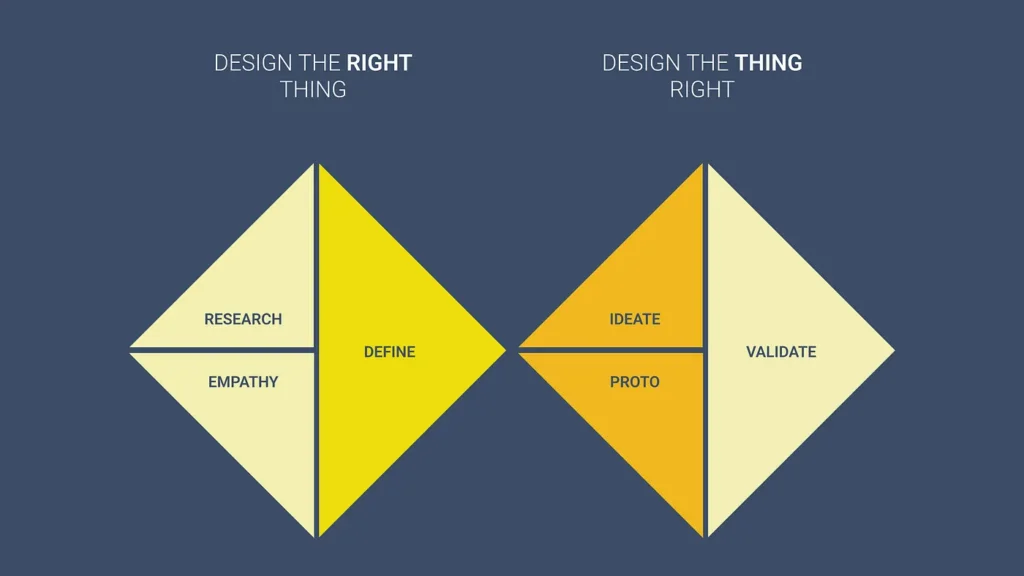In recent months, now navigating a period of unemployment, I’ve poured my energy into connecting with people across diverse crafts and backgrounds. It’s been an eye-opening journey to listen, observe, and piece together the dynamics shaping our industry. One insight that recently struck me is how venture capital (VC) firms exert a profound influence not just on which products make it to market, but on how they’re resourced, designed, and developed.
These resources, ranging from financial support, strategic guidance, and vast networks, can make or break a company’s journey from concept to success. However as VCs increasingly take on roles in talent acquisition, particularly in sourcing key hires for product and design roles, there are some unintended consequences for Product Design as a discipline. This article explores the resources VCs provide to startups, how their influence affects Product Design and Design Leadership, and how we, as an industry, can course-correct to build more sustainable, creative, and strategically empowered design teams.
The VC value proposition: fueling growth through supercharging resources
Venture capital firms have long played a crucial role in the startup ecosystem. Their purpose is clear: identify promising startups, invest in them, and help them grow quickly so that both the startup and the VC see returns. Traditionally, this value proposition includes:
- Financial investment: Capital infusion that fuels a startup’s growth.
- Strategic guidance: High-level advice on business development, scaling, and market positioning.
- Network access: Connections to other companies, partners, and talent that would otherwise take years to establish.
VCs provide these resources with the intention of maximizing the startup’s chances of success. However, the manner in which they provide resources, particularly in areas like Talent Acquisition and Team Building, is increasingly shaping the future of Product Design as a craft and, by extension, the overall user experience.
The rise of VC influence in talent acquisition
As startups scale, finding the right talent becomes a critical success factor. This is where VCs often step in, either by helping to source talent directly or by recommending third-party hiring firms. However, a significant challenge arises when non-design professionals, often from investment or operational backgrounds, take the lead in hiring design and product teams. They may lack the nuanced understanding required to identify not only technical skills but also the leadership qualities, strategic vision, and creative acumen that distinguish impactful design leaders.
It’s been an eye-opening journey to listen, observe, and piece together the dynamics shaping our industry.
Non-design talent in the driver’s seat: the risks
It’s common for VCs to step in during hiring, especially for leadership roles, but when VCs are driving the design hiring process, the results can be problematic. Here are some of the key issues that can arise:
- Misaligned job descriptions: When hiring decisions are led by people with limited Product Design experience, job descriptions tend to focus on operational and execution tasks rather than strategic and creative competencies. Roles are crafted with an emphasis on deliverables, rather than outcomes, and often overlook the strategic value that design leaders bring to the table.
- Under-appreciation for Product Design as a partner function: Many VCs view design as a functional discipline rather than a partner in product innovation. This perception influences the kinds of leaders they seek, often, they prioritize those with a track record of shipping products quickly rather than those who bring a strong vision for user experience, branding, or customer insights.
- Reliance on standardized hiring metrics: Without a deep understanding of what makes design teams effective, VCs and hiring firms may prioritize easy-to-measure factors like years of experience, size of an org, familiarity with specific tools (cough, insert Figma reference!), or the number of successful launches, rather than more intangible qualities such as building cultures of innovation, understanding customer needs, storytelling & vision setting, and collaborative ability.
These hiring practices create teams that are optimized for output rather than innovation, reinforcing a view of design as a delivery mechanism rather than a strategic driver.
The impact on Design Leadership: closed doors, reduced influence, limited innovation
When design leaders are chosen based on criteria set by those outside the craft, the result is often a team that focuses on execution rather than strategy. Here’s how this manifests across teams and organizations:
Experienced leaders’ expertise dismissed
The expertise of seasoned design leaders is often overlooked, assessed through the narrow lens of “hands-on” comfort by non-craft reviewers. The problem is that “hands-on” is a broad term, spanning everything from delivering screens to unifying workflows, establishing design systems, and guiding work through rituals like critiques. Depending on how you measure it, design leaders can either be an additive presence or a multiplier, amplifying value far beyond surface-level contributions.
Design as a delivery function, not a strategic partner
In many VC-backed companies, design is seen as a means to an end, a team that makes products look good and function smoothly, but not as a partner in defining what products should be. This approach limits Product Design’s impact on the product vision, as well as on company-wide initiatives. When designers are brought in too late in the product development process or are excluded from strategic discussions, it reinforces the perception that design is simply a “make it look pretty” function rather than a core element of user-centered innovation.
Design leaders as task managers
When design leaders are selected based on their ability to execute rather than their strategic vision, they’re often tasked with managing outputs, checking off deliverables, and meeting deadlines. This expectation severely limits their ability to shape the product from a higher level. Instead of serving as influential partners to product and engineering leaders, design leads are often constrained to ensuring things “look right” or “fit the brand.” This dynamic leads to burnout, turnover, and a sense of stagnation among designers, as they find themselves unable to contribute meaningfully to the company’s mission or innovation.
The broader impact: boilerplate design and failure to meet product-market fit
When VCs drive talent acquisition without a nuanced understanding of design, the result is often homogenised products. Without strong, strategically-minded design leadership, companies risk creating products that look and feel generic, that fail to differentiate themselves, or that simply mimic what’s already out there. In a competitive market, this is a dangerous pitfall. Without unique, thoughtfully designed experiences, products struggle to resonate with users on a deeper level, leading to reduced brand loyalty and limited growth potential.
Even more critically, Product-Market Fit (PMF) often slips through the cracks when design isn’t empowered to drive discovery and innovation. The divergent thinking phase of the Double Diamond process is crucial here, as it reduces risk and enhances the likelihood of hitting the mark.
Design as a delivery function to a defined Product Requirements Document (PRD). In this model, the assumption is that the “thing” just has to be pretty or usable to meet customer expectations. Risky assumption indeed…

Course correction: how design leaders & VCs can shape the future
While the issues we’ve outlined are challenging, they’re not without solutions. Product Design leaders have a vital role to play in shaping the future of the industry, particularly in VC-backed environments. Here’s how we can move forward.
Redefine product design’s role in the organization
Design leaders need to proactively redefine what design brings to the table. This means advocating for design as a partner function early in the startup’s lifecycle and educating other leaders, particularly VCs, on the strategic value of design. By demonstrating how design contributes to “Designing the right thing”, design leaders can shift the conversation from outputs to outcomes. Tangibly these measures might be how the craft contributes to user retention, product differentiation, and long-term brand equity.
VC’s, understand that while speed to market is a critical factor, being wrong is more expensive. Shipping fast, and spending valuable engineering resources on a PMF that’s off-target is wasteful. Consider the cost efficiency of building a level of confidence (rigor), and creating a culture of innovation (multiplier). I would argue that’s cheaper than building fast, praying the decisions and market assumptions were correct.
Engage in advisory roles for Talent Acquisition
Design leaders should have a direct role in the hiring process, especially for IC and leadership positions within design. This doesn’t mean they should handle hiring alone, but rather work collaboratively with VCs and other executive teams to define job descriptions, assess candidates, and set expectations. By positioning themselves as advisors, they can ensure that new hires bring not only the necessary skills but also a strategic mindset and a commitment to the company’s mission and values.
For this to happen, and to attract the experience required to effect change, rates need to reflect intent. A daily rate matching that of a Senior Product Designer will not incentivise Design leaders at the calibre required.
Establish metrics for strategic value, not just delivery
In VC-backed environments, metrics matter. Design leaders can influence how success is measured by establishing KPIs that reflect design’s strategic contributions. Instead of measuring team success solely by the number of screens delivered or deadlines met, include metrics such as user engagement, time on task, task completion rate, and customer satisfaction. By establishing meaningful metrics, design can reinforce its role as a driver of product innovation.
Cultivate a culture of continuous learning and growth
VC-backed startups often are required to move at breakneck speed, but it’s essential to build a culture that values continuous learning and growth. Design leaders can encourage a mindset of curiosity and resilience, supporting professional development initiatives and advocating for ongoing education. This creates a healthier, more engaged team and sends a message to the wider organization that design is a long-term asset, not just a project-based function.
It’s on VCs to wake up to the value of design leadership, in ways broader than the output of Figma. Design leadership contributing to shaping the PMF, providing the conditions for great work, up-skilling entire teams, and managing creative futures of teams, is the gig.
Conclusion: a call to action for design leaders and VCs alike
Venture capital firms undeniably play a powerful role in shaping the trajectory of today’s startups, but their influence in areas like talent acquisition and team building must be balanced with the nuanced expertise of design leaders. By working together, VCs and design leaders can foster teams that are not only highly capable in execution but also deeply strategic, and capable of driving meaningful innovation that resonates with users.
For design leaders, the time is now to advocate for a stronger, more strategic role in their organizations, to actively participate in talent acquisition, and to redefine success in ways that go beyond deliverables. And for VCs, embracing Product Design as a partner in innovation rather than a delivery function can transform the impact of their investments, leading to products that don’t just work but delight and inspire.
Together, we can shape a future where design is not merely an afterthought but a driver of growth, a partner in strategy, and a catalyst for meaningful, user-centered innovation.
Any scaling businesses curious about growing their design leadership presence, feel free to reach out. Happy to chat about the opinions of this post and how I might be able to help.
I’m available in an Advisory capability for Venture Capital firms building teams with Product Design requirements. I’ll advise on the right skillset, sourcing candidates from my broad network, and embedding innovation at the core.
I have affordable rates for Advisory, Fractional Leadership support, or bespoke packages in the traditional Venn diagram of Design Leadership: People, Practice, and Strategy.
The article originally appeared on Medium.
Featured image courtesy: Getty Images.








